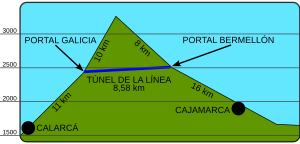La Línea (tunnel) facts for kids
La Línea (which means The Line in English) is a very important highway tunnel in Colombia. It connects the cities of Calarcá in Quindío and Cajamarca in Tolima.
This amazing tunnel goes right under the famous "Alto de La Línea" mountain pass. This pass is part of the Central Andes Mountains. The tunnel helps traffic flow much better on one of Colombia's main roads, National Route 40. This road links the capital city, Bogotá, with Cali and the important Pacific port of Buenaventura.
The La Línea tunnel is the longest road tunnel in all of Latin America and even in the entire Americas! It's much longer than the 13,300 ft (4,100 m) Anton Anderson Memorial Tunnel in North America.
The tunnel is 8,652 metres (28,386 ft) long. Its western entrance is 2,420 metres (7,940 ft) above sea level, about 19 kilometres (12 mi) east of Armenia. The eastern entrance is a bit higher, at 2,505 metres (8,219 ft) above sea level, about 37.8 kilometres (23.5 mi) west of Ibagué.
Building this huge project took a long time. Work on a smaller "pilot" tunnel started on September 30, 2004. Both sides of this pilot tunnel met on August 2, 2008. In September 2007, the Ministry of Transport started looking for companies to build the main tunnel and its connecting roads.
Construction officially began in December 2008. A group called Union Temporal Segundo Centenario, led by Carlos Collins, was in charge. The tunnel was first expected to open in 2016. But in May 2016, the opening was pushed back to 2018. Finally, after 14 years of hard work, the La Línea tunnel opened on September 4, 2020. It cost about 2.9 trillion Colombian pesos, which is around US$870 million.
Why La Línea Tunnel is Awesome
The La Línea tunnel brings many great benefits for travelers and the country.
Saving Money and Time
- Lower Costs: Driving through the tunnel means less wear and tear on vehicles. This saves about US$37 million in operating costs in the first year alone!
- Faster Travel: The average speed on this route will increase a lot, from 18.2 kilometres per hour (11.3 mph) to 60 kilometres per hour (37 mph).
- Shorter Trips:
* Big trucks can save up to 80 minutes of travel time. * Smaller cars can save 40 minutes.
Safer Journeys
- Fewer Accidents: The old mountain road was very dangerous. It had four times more accidents than the national average because of its tricky geography and weather.
- Increased Safety: The tunnel is expected to make the accident rate drop to the national average, making trips much safer for everyone.
Overall, the tunnel is estimated to bring about US$40 million in economic benefits every year!
See also
- In Spanish: Túnel de la Línea para niños


